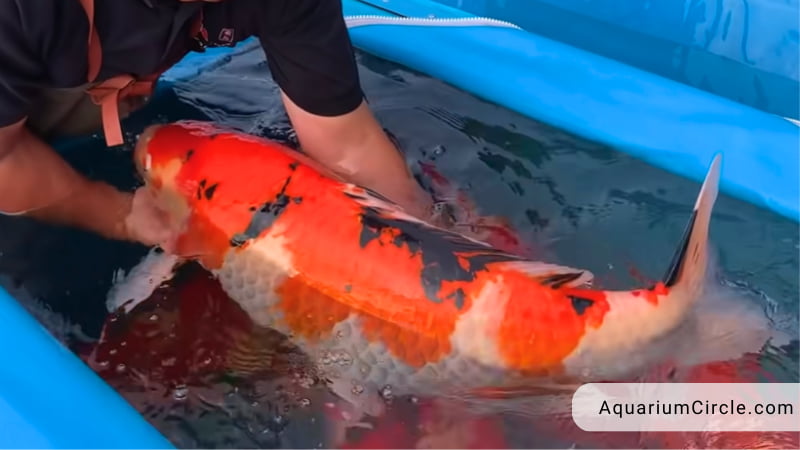Have you ever wondered “how big do koi fish get?” Koi fish are a popular species of freshwater fish that have been bred for centuries for their ornamental beauty and impressive size. These fish can grow to be quite large, and their size can vary depending on several factors, such as genetics, environment, nutrition, and water quality. In this article, we will explore the growth stages of koi fish, their average size and weight, and provide some tips on how to care for these beautiful creatures.
See also:
- How Long Do Koi Fish Live? 7 Factors Affecting Koi Lifespan And Helpful Tips To Lengthen Their Average Lifespan
- Answered: Your Most Burning Questions About What Color Are Baby Koi Fish
- Are Koi Fish Aggressive? Here’s What You Need To Know
How Big Do Koi Fish Get? Best Answer About Koi Fish Size
Koi fish can grow to be quite large, with the average length ranging from 20 to 36 inches (50 to 90 cm) and the weight ranging from a few ounces to over 50 pounds (22 kg). However, the size of a koi fish can be affected by various factors, such as genetics, environment, nutrition, and water quality that will be disscussed in the next section. Koi fish can live for several decades, with some living up to 50 years or more. Proper care, including a suitable environment, proper nutrition, and regular checkups, can help ensure that your koi fish reach their full potential size and live a healthy, happy life.
Factors Affecting Koi Fish Growth Rate
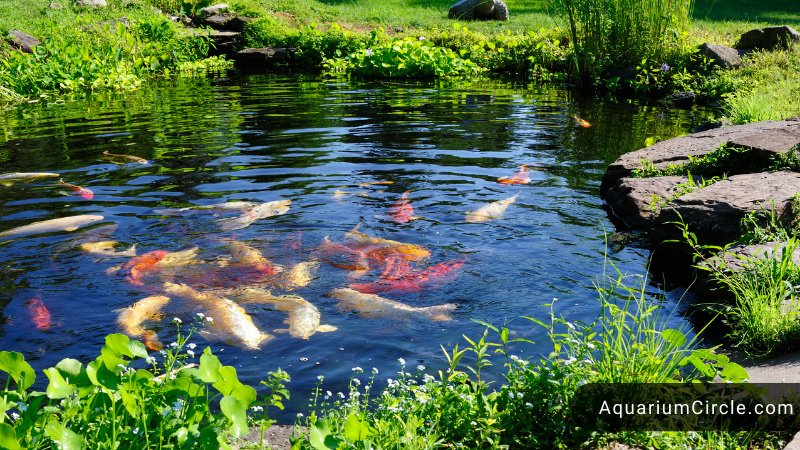
Genetics
Genetics plays a crucial role in determining the growth rate and potential size of koi fish. Koi fish that come from superior genetic lines have a higher potential for growth and can grow larger than those with inferior genetics.
Selective breeding is commonly used to develop koi fish with desirable traits such as vibrant colors, unique patterns, and large size. By selectively breeding fish with desirable traits, breeders can enhance the genetics of the offspring and produce fish with better growth potential.
Water Temperature
Water temperature is a crucial factor that affects the growth rate of koi fish. The ideal water temperature for koi fish growth is between 68°F and 75°F (20°C to 24°C), as this temperature range allows for optimal digestion and metabolism.
When the water temperature is too low, the metabolism of koi fish slows down, leading to decreased growth rates and reduced appetite. If the water temperature is too high, koi fish may become stressed and experience reduced oxygen levels, which can also negatively impact their growth.
In addition to the temperature range, consistency in temperature is also important. Rapid changes in water temperature can stress the fish and cause health problems, which can also affect their growth.
Maintaining a consistent water temperature within the ideal range is crucial for ensuring that koi fish grow at their optimal rate. Using a thermometer and a reliable heating and cooling system can help maintain the ideal water temperature for koi fish growth.
Stress
Stress can significantly affect the growth rate of koi fish. Stress can arise from a variety of factors, such as overcrowding, aggressive tank mates, poor water quality, or sudden changes in the environment.
When koi fish experience stress, their metabolism slows down, and their immune system becomes compromised, making them more susceptible to diseases and infections. This can cause a decrease in appetite and a reduction in growth rate.
Stressed koi fish may also become more aggressive towards each other, leading to injuries or fights that can further impact their health and growth.
To prevent stress in koi fish, it is essential to maintain a suitable environment that provides adequate space, good water quality, and compatible tank mates. Regular water changes, proper filtration, and providing a balanced and nutritious diet can also help reduce stress and promote healthy growth.
Nutrition
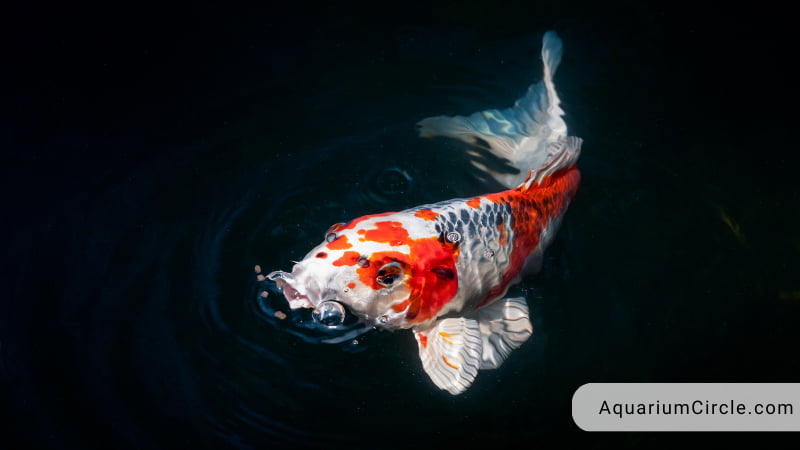
Nutrition is a crucial factor that affects the growth rate of koi fish. Koi fish require a balanced and nutritious diet that is high in protein to promote healthy growth. Protein is essential for building and repairing muscle tissue, which is necessary for koi fish growth.
Feeding koi fish with low-quality or inappropriate food can stunt their growth and cause various health problems. Overfeeding koi fish can also lead to obesity, which can further impact their growth and health.
It is essential to provide koi fish with a balanced diet that meets their nutritional requirements. Koi fish food should be high in protein and include a variety of ingredients such as fishmeal, shrimp, spirulina, and vegetables.
Feeding koi fish multiple times a day, but in small portions, can help ensure that they receive the necessary nutrients without overfeeding. It is also essential to avoid overfeeding and regularly clean up uneaten food to maintain good water quality.
By providing koi fish with a nutritious and balanced diet and avoiding overfeeding, you can help ensure that they grow at their optimal rate and live a healthy life.
See also: Can Koi Fish Eat Dog Food? 3 Fun Treats To Feed Koi Instead
Overcrowding
Overcrowding can significantly affect the growth rate of koi fish. When too many koi fish are kept in a small space, they compete for resources such as food, oxygen, and space, which can lead to stress, stunted growth, and reduced appetite.
Overcrowded conditions can also increase the levels of ammonia and other harmful substances in the water, which can negatively impact the health and growth of koi fish.
To prevent overcrowding, it is essential to provide koi fish with an adequately sized environment that allows them to swim freely and provides adequate space for each fish. A general rule of thumb is to provide at least 500 gallons of water per koi fish to ensure that koi can grow to maximum size.
In addition to providing enough space, it is also important to monitor the water quality regularly and perform regular water changes to maintain good water quality. By avoiding overcrowding and providing a suitable environment for koi fish, you can help ensure that they grow at their optimal rate and live a healthy life.
What Is The Biggest Koi Fish Recorded?
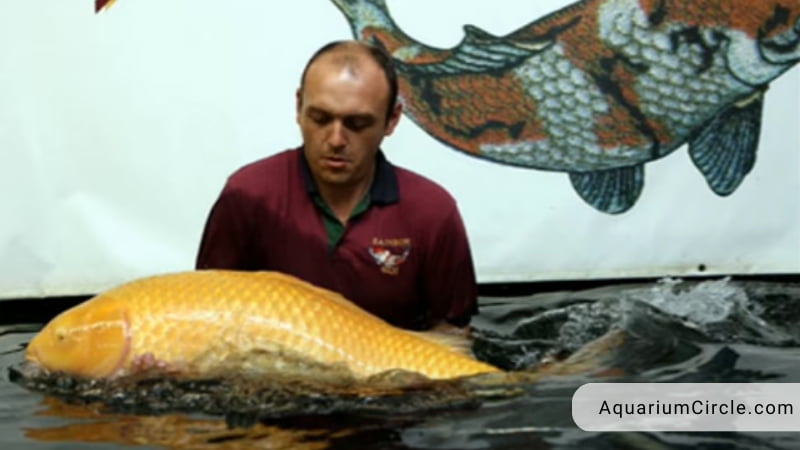
“Big Girl” is the biggest koi fish recorded to date. It is a female Kohaku koi fish, which is a white fish with red markings. She was bred by Kentaro Sakai in Hiroshima, Japan and was born in 2007.
At her sale in 2017, “Big Girl” was touted as the largest koi fish ever recorded, measuring 4 feet 3 inches (129.5 cm) in length and weighing around 94 pounds (42.6 kg). Her impressive size and striking coloration make her a highly sought-after specimen among koi collectors.
Despite her size, “Big Girl” is still growing, and her current owners are continuing to provide her with proper care and nutrition to help her reach her full potential size. Koi fish can live for several decades, and it is not uncommon for them to continue growing throughout their lifetime, although at a slower rate as they age.
The sale of “Big Girl” for $1.8 million USD in 2017 broke the previous record for the most expensive koi fish ever sold, highlighting the significant value that these ornamental fish can hold in the koi collecting community.
How Big Do The Most Well-known Koi Fish Varieties Get?
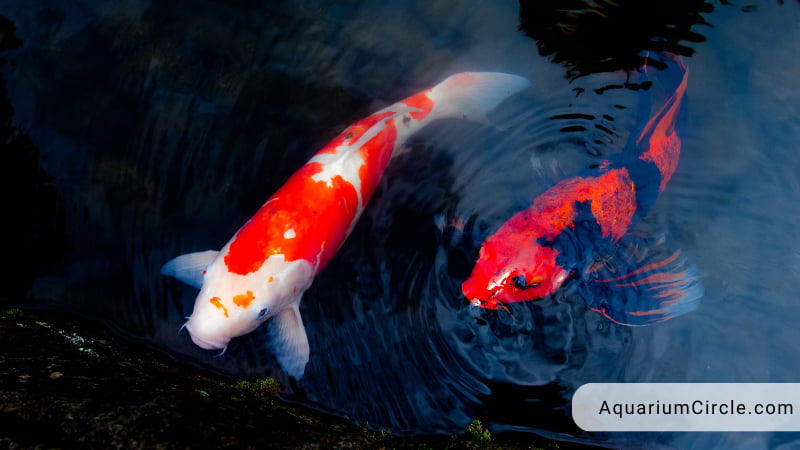
There are many types of koi fish, each with their own unique colors and patterns. Here is a breakdown of the most common koi fish varieties by their category:
Domestic koi
- Butterfly Koi: These koi have long flowing fins that resemble butterfly wings. They can grow up to 36 inches (90 cm) in length and can weigh up to 20 pounds (9 kg).
- Ghost Koi: Ghost koi are a hybrid of koi and wild carp. They can grow up to 36 inches (90 cm) in length and can weigh up to 20 pounds (9 kg).
Japanese koi
- Kohaku: These koi have a white body with red markings. They can grow up to 36 inches (90 cm) in length and can weigh up to 20 pounds (9 kg).
- Sanke: Sanke koi have a white body with red and black markings. They can grow up to 36 inches (90 cm) in length and can weigh up to 20 pounds (9 kg).
- Showa: Showa koi have a black body with red and white markings. They can grow up to 36 inches (90 cm) in length and can weigh up to 20 pounds (9 kg).
- Asagi: Asagi koi have a blue-gray body with red and white markings. They can grow up to 28 inches (70 cm) in length and can weigh up to 10 pounds (4.5 kg).
- Shusui: Shusui koi have a blue-gray body with red and white markings. They can grow up to 28 inches (70 cm) in length and can weigh up to 10 pounds (4.5 kg).
Jumbo koi
- Jumbo Ogon: These koi are the largest of the Ogon variety, with a metallic appearance in gold, platinum, and silver colors. They can grow up to 4 feet (120 cm) in length and can weigh up to 60 pounds (27 kg).
- Jumbo Showa: These koi are the largest of the Showa variety, with a black body and red and white markings. They can grow up to 4 feet (120 cm) in length and can weigh up to 60 pounds (27 kg).
How Long Does It Take A Koi Fish To Grow To Full Size?
The time it takes for a koi fish to reach full size can vary depending on various factors such as genetics, environment, nutrition, and water quality. On average, it takes about 3-4 years for koi fish to reach their full potential size.
During the first year of their life, koi fish typically grow rapidly and can increase in size by 1-2 inches per month. However, growth rates will slow down as they get older, and it can take several more years for them to reach their full potential size.
How Fast Do Koi Fish Grow?
On average, koi fish can grow about 1-2 inches (2.5-5 cm) per year during their first few years of life.
During the first year of their life, koi fish typically experience the most rapid growth, and it is not uncommon for them to grow up to 10 inches (25 cm) in their first year. However, growth rates will slow down as they get older, and it can take several more years for them to reach their full potential size.
What Can We Do To Boost The Growth Of Koi Fish In Our Pond?
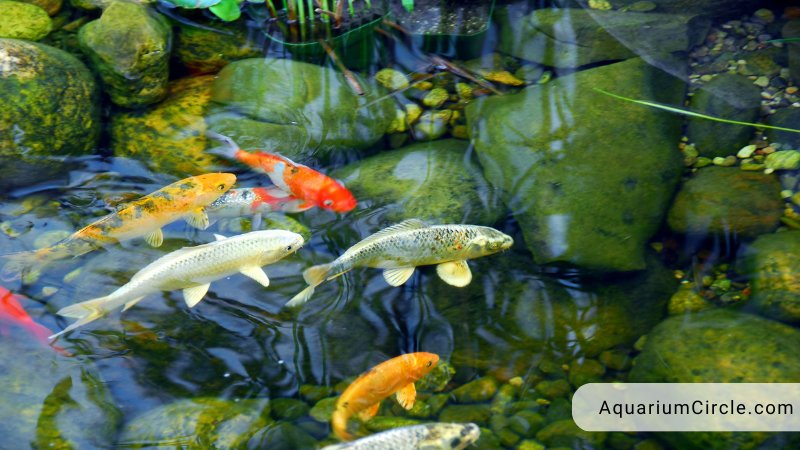
To boost the growth of koi fish in a pond, there are several things you can do:
Provide a suitable environment
Koi fish require a clean and spacious environment with good water quality to thrive and grow. When their environment is not suitable, it can lead to stress, disease, and stunted growth.
A suitable environment for koi fish should have a pond with adequate water volume and filtration to maintain good water quality. The pond should be deep enough to allow the fish to swim freely and provide hiding places to reduce stress.
A suitable environment should also have the ideal water temperature for koi fish, which is between 68°F and 75°F (20°C to 24°C). The temperature should be consistent to prevent temperature fluctuations, which can cause stress and negatively affect their growth.
In addition, providing proper nutrition and adequate oxygen is essential for promoting healthy growth. A suitable environment ensures that koi fish have access to a balanced and nutritious diet and sufficient oxygen levels to support their metabolism and growth.
Feed a nutritious diet
Feeding a nutritious diet is essential for boosting the growth of koi fish. Koi fish require a diet that is high in protein to support their growth and development. A well-balanced diet should include a variety of ingredients such as fishmeal, shrimp, spirulina, and vegetables.
The amount of food you feed your koi fish should be appropriate for their size and age. Overfeeding can lead to obesity, which can negatively impact their growth and overall health. Feed your koi fish multiple times a day, but in small portions to avoid overfeeding.
In addition to providing a balanced diet, you can also consider adding supplements to support their growth and overall health. Vitamins and minerals such as vitamin C, vitamin E, and calcium can help support healthy growth and strengthen their immune system.
Provide adequate oxygen
Providing adequate oxygen is also crucial for boosting the growth of koi fish. Koi fish require a sufficient amount of oxygen to support their metabolism and growth. Inadequate oxygen levels can lead to stress, disease, and stunted growth.
There are several ways to provide adequate oxygen for koi fish. One way is to use a pond aerator or fountain, which helps to circulate the water and increase oxygen levels. Another way is to add plants to the pond, which release oxygen during photosynthesis.
Proper filtration is also essential for maintaining adequate oxygen levels in the pond. A well-designed filtration system helps to remove waste and debris from the water, which can consume oxygen and reduce the available oxygen levels for fish.
It is essential to monitor the oxygen levels in the pond regularly, especially during the summer months when oxygen levels can decrease due to high temperatures. If oxygen levels are low, you can add an air pump or adjust the filtration system to increase oxygen levels.
Monitor for parasites and diseases
Parasites and diseases can negatively impact their growth and overall health, and if left untreated, can even be fatal.
Common parasites that can affect koi fish include ich, anchor worm, and flukes. Signs of parasitic infections may include visible parasites on the fish, a change in behavior, loss of appetite, or abnormal growth.
Common diseases that can affect koi fish include bacterial infections, fungal infections, and viral infections. Signs of a disease may include red spots or lesions on the skin, swollen or discolored fins, or lethargy.
It is important to monitor your koi fish regularly for any signs of illness or parasites. Early detection can help ensure that treatment is effective and can prevent the spread of disease to other fish in the pond.
If you suspect that your koi fish may have a parasitic infection or disease, you should consult a veterinarian or an experienced koi keeper for advice on treatment. Treating parasites and diseases promptly can help ensure that your koi fish remain healthy and continue to grow at their optimal rate.
See also: Why Is My Koi Fish Swimming Upside Down: 6 Useful Treatments
Video About How Big Do Koi Fish Get
FAQs
What is the average length of a Koi fish?
The average length of a Koi fish is around 20 to 36 inches (50 to 90 cm).
How heavy can Koi fish get?
Koi fish can weigh anywhere from a few ounces to over 50 pounds (22 kg).
What is the lifespan of Koi fish?
Koi fish can live for several decades, with some living up to 50 years or more.
How do you know if a Koi fish is fully grown?
Koi fish typically reach their full size at around 3 to 5 years of age. However, their growth can be affected by various factors.
Can Koi fish grow too big for their pond?
Yes, Koi fish can outgrow their pond if it is too small. It is important to ensure that the pond is big enough to accommodate the size of the fish.
References

Annette M. Chaney is an experienced marine biologist with over 20 years of experience as an aquarist and fishkeeper. She started her first aquarium at a young age, filling it with frogs and goldfish obtained from the ten-cent pet store.
Annette grew up caring for and breeding African Cichlids, which led to a hobby in high school that doubled as a profitable means. Attending Reed College gave her time to solidify herself as an accomplished aquarium caretaker with an eye for sales. After that, from 2009 – 2013, she studied at Roger Williams University – one of the most prestigious universities for Aquaculture and Aquarium in USA. She is the founder of AquariumCircle since 2010.
